Welcome to my article on battling worms in your pregnant cat! As a loving cat owner, it’s important to understand the risks and take proactive steps to protect the health of your furry friend and her unborn kittens. In this comprehensive guide, I’ll provide you with valuable information on common worm infections in cats, signs of worm infestation in pregnant cats, and the necessary steps for prevention and treatment during pregnancy. Let’s dive in and ensure the well-being of your pregnant cat and her future kittens!
Key Takeaways:
- Pregnant cats are susceptible to worm infections due to the transmission of worm larvae through nursing and ingestion of prey.
- Roundworms are common parasites that can infect cats and have serious health consequences if left untreated.
- Signs of worm infestation in pregnant cats may include vomiting, diarrhea, decreased appetite, and a pot-bellied appearance.
- Deworming pregnant cats and following preventive measures is crucial for the health of the mother and her kittens.
- Regular veterinary care, a balanced diet, and a safe environment are essential for the well-being of pregnant cats and their offspring.
What Are Roundworms and Why Should You Care?
Roundworms, also known as toxocara cati or toxascaris leonina, are one of the most common intestinal parasites in cats. These parasites typically reside in the intestines of infected cats and can grow to be 3-6 inches long. While adult cats may not show any symptoms, roundworms can cause severe health issues in kittens, older cats, and those with compromised immune systems.
Aside from the detrimental effects on feline health, roundworm eggs can also be transmitted to humans, especially children. This happens through contact with contaminated soil or infected animals. Therefore, it is crucial for pet parents to be aware of roundworm infestations and take appropriate measures to prevent and treat them in order to protect both their cats and themselves.

Dealing with roundworms is crucial not only for the well-being of your furry friend but also for the overall health and safety of your household. By understanding the significance of roundworms and their impact on feline health, you can take the necessary steps to prevent and treat these parasites effectively.
How Do Cats Get Roundworms?
There are several ways in which cats can become infected with roundworms. One common route is through ingesting worm eggs or young worms, which then migrate through the cat’s muscles, liver, and lungs. Eventually, they reach the intestines, where they reproduce and release eggs into the cat’s stool. Kittens can also acquire roundworms through nursing, as dormant worm cysts in the mother’s organs may become active during pregnancy and migrate to the mammary glands.
Another way cats can get roundworms is through the consumption of prey animals like mice, birds, or insects. Roundworm eggs can be found in the tissues of these prey animals, and when a cat eats them, they can become infested with roundworms. It’s important to note that roundworms can also be transmitted between cats through direct contact or contaminated environments.
It is crucial for pet parents to be aware of these transmission pathways and take preventive measures to minimize the risk of roundworm infection in their cats. Regular deworming, proper hygiene, and keeping cats indoors can all help reduce the chances of roundworm infestation.

Preventing Roundworm Infection in Cats
To prevent cats from getting roundworms, there are several measures pet parents can take:
- Deworming: Regularly deworming your cat can help eliminate any existing roundworm infestations and prevent new infections.
- Good hygiene practices: Cleaning litter boxes regularly and practicing proper hand hygiene can help reduce the risk of roundworm transmission.
- Indoor living: Keeping cats indoors can minimize their exposure to environments where roundworm eggs may be present.
- Preventing hunting: If your cat is an outdoor hunter, using deterrents or providing alternative sources of enrichment can help reduce their prey consumption and the risk of roundworm infection.
Recognizing and Treating Roundworm Infection
It’s important to be able to recognize the signs of roundworm infection in cats. Symptoms can include vomiting, diarrhea, weight loss, a pot-bellied appearance, and the presence of worms in the stool or vomit. If you suspect your cat has roundworms, it’s essential to consult with a veterinarian for an accurate diagnosis and appropriate treatment.
Veterinarians may recommend a fecal flotation test to detect the presence of roundworm eggs in the cat’s stool. If roundworms are found, deworming medications will be prescribed to eliminate the parasites. Treatment may need to be repeated to ensure complete eradication of the infection.
Regular veterinary check-ups and preventive measures can go a long way in keeping your cat safe from roundworms and maintaining their overall health and well-being.
Symptoms of Roundworm Infection in Cats
Cats infected with roundworms may exhibit various symptoms or may not show any signs at all. Common symptoms of roundworm infestation include:
- Vomiting: Cats may vomit due to the irritation caused by the presence of roundworms in their digestive system.
- Diarrhea: Infected cats may have loose stools or diarrhea, which can be a result of the inflammation caused by the parasites.
- Worms in stool: Roundworms can sometimes be visible in the cat’s stool or vomit, resembling spaghetti-like worms.
- Decreased appetite: Cats with roundworms may lose their usual appetite and show reduced interest in food.
- Pot-bellied appearance: Roundworm infestations can cause the abdomen to appear swollen or distended, giving the cat a pot-bellied appearance.
- Abdominal pain: Cats may demonstrate signs of discomfort or pain in the abdominal area.
- Poor growth: Kittens infected with roundworms may experience stunted growth and fail to reach normal developmental milestones.
- Weight loss: Unexplained weight loss can be a symptom of roundworm infestation, especially if the cat’s appetite is reduced.
- Dull hair coat: The presence of roundworms can affect the cat’s overall health, leading to a lackluster or dull hair coat.
- Coughing: If roundworm larvae migrate to the respiratory system, cats may develop a cough as a result of the irritation.
It is important for pet parents to pay attention to their cat’s behavior and physical condition, as timely detection of roundworm infestation can ensure prompt treatment and prevent complications.
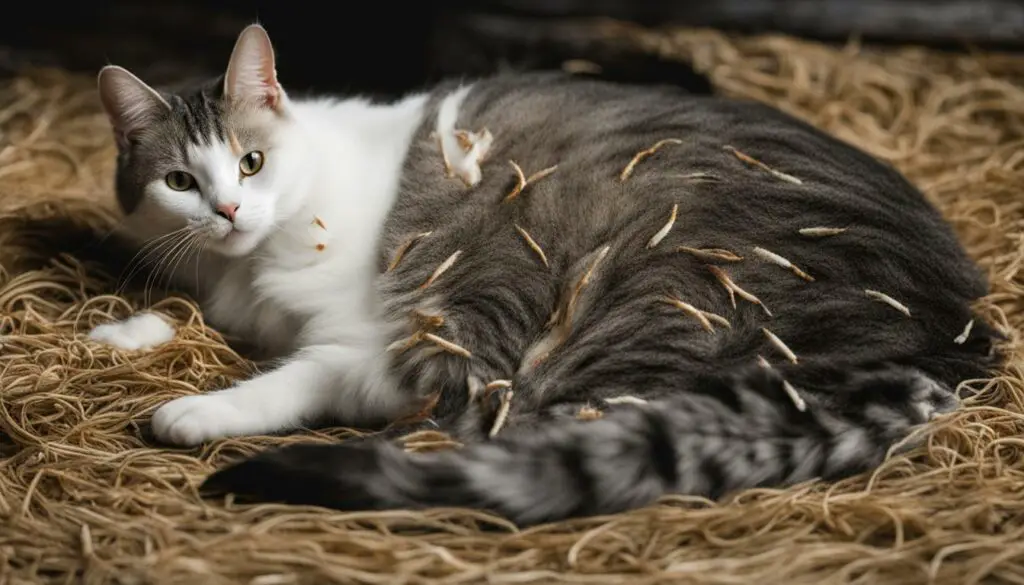
“Cats infected with roundworms may exhibit various symptoms or may not show any signs at all.”
How to Diagnose Roundworm Infection in Cats
Diagnosing roundworm infection in cats typically involves a fecal flotation test, which is performed by a veterinarian. This test helps identify the presence of roundworm eggs in the cat’s stool. It involves mixing a small amount of the stool with a solution that allows the microscopic eggs of the roundworms to float to the top. The veterinarian can then examine the floatation solution under a microscope to detect the eggs.
However, it is important to note that fecal flotation tests may not always provide accurate results, especially if the cat is infected with young worms that have not yet started producing detectable eggs. This can lead to false negatives, where the test results indicate no infection even if the cat is infested with roundworms. Therefore, if clinical signs or risk factors suggest a roundworm infestation, your veterinarian may recommend treatment based on the symptoms, even if the test results are negative.
| Possible Test Results | Interpretation |
|---|---|
| Positive for roundworm eggs | Confirmation of roundworm infection |
| Negative for roundworm eggs | Possible false negative, especially if the cat is infected with young worms |
In some cases, additional diagnostic tests may be necessary to confirm a roundworm infestation. These tests may include blood tests to monitor the cat’s overall health and check for specific antibodies against roundworms. Your veterinarian will determine the most appropriate diagnostic approach based on the cat’s symptoms, medical history, and risk factors.
Treating and Preventing Roundworm Infections in Pregnant Cats
Pregnant cats are more susceptible to roundworm infections due to the transmission of worm larvae through nursing and ingestion of prey. Treating and preventing roundworm infections is essential for the health of both the mother and her kittens. A safe and effective treatment option is deworming medication, which should be administered according to the veterinarian’s recommendation. Regular deworming during pregnancy helps eliminate any existing roundworms and prevents re-infestation.
In addition to deworming, pregnant cats should be on a routine parasite prevention program, including preventive measures for other common parasites like fleas and ticks. This can help minimize the risk of roundworm transmission and ensure the overall health of the pregnant cat and her kittens. It is crucial to consult with a veterinarian for specific parasite preventative recommendations and to follow their guidelines closely.
Preventing worm infections in pregnant cats also involves minimizing their exposure to potential sources of infestation. Keeping pregnant cats indoors can reduce their contact with contaminated soil or infected prey animals. Indoor confinement helps create a controlled environment that reduces the risk of roundworm transmission. By implementing these safe and effective treatment and prevention measures, pet parents can help ensure a healthy pregnancy and minimize the chances of roundworm infections in pregnant cats.

Table: Comparison of Treatment and Prevention Measures for Roundworm Infections in Pregnant Cats
| Treatment Measures | Prevention Measures |
|---|---|
| Deworming medication as per veterinarian’s recommendation | Routine parasite prevention program |
| Eliminates existing roundworms | Reduces the risk of roundworm transmission |
| Safe and effective treatment option | Includes preventive measures for fleas and ticks |
| Regular deworming during pregnancy | Minimizes exposure to potential sources of infestation |
| Indoor confinement to reduce contact with contaminated soil or infected prey animals |
By following these treatment and prevention measures, pet parents can ensure the overall well-being of their pregnant cats and their kittens. Regular veterinary care, including deworming and parasite preventative measures, plays a vital role in maintaining a healthy pregnancy and reducing the risk of roundworm infections. Early intervention and proactive prevention are key to ensuring the lifelong health and happiness of both the mother and her kittens.
Vet Care for Your Pregnant Cat: Vaccines, Deworming, and Check-ups
Providing proper veterinary care for your pregnant cat is essential to ensure her health and the health of her kittens. Regular check-ups, vaccinations, and deworming are crucial components of maintaining a healthy pregnancy and preventing potential complications.
During your cat’s pregnancy, it is important to follow the veterinarian’s recommended vaccination schedule. Vaccines help protect your cat against common infectious diseases, such as feline herpesvirus, calicivirus, and panleukopenia. However, it is essential to consult with your veterinarian to ensure that the vaccines are safe for pregnant cats, as some may need to be avoided or postponed until after delivery. Vaccinations not only protect your cat but also provide immunity to the kittens through the transfer of antibodies in the mother’s milk.
Deworming is another crucial aspect of vet care for pregnant cats. Worm infestations can have detrimental effects on the health of both the mother and her kittens. Deworming medication is safe and effective and should be administered according to the veterinarian’s recommendation. It helps eliminate any existing worm infestations and prevents reinfestation during pregnancy. This not only protects the mother cat but also reduces the risk of transferring worms to the kittens during nursing.
In addition to vaccinations and deworming, regular check-ups with the veterinarian are essential to monitor the overall health and progress of your pregnant cat. These check-ups allow the veterinarian to assess the cat’s weight gain, monitor vital signs, and address any concerns or complications that may arise. Your veterinarian may also recommend additional tests or examinations, such as blood work or ultrasounds, to ensure the health and well-being of your cat and her kittens.
| Vet Care for Pregnant Cats | Benefits |
|---|---|
| Vaccinations | Protects against infectious diseases and provides immunity to kittens |
| Deworming | Eliminates and prevents worm infestations in the mother and reduces the risk of transmission to kittens |
| Regular Check-ups | Monitors overall health, addresses concerns, and ensures the well-being of the cat and her kittens |
Regular veterinary care, including vaccinations, deworming, and check-ups, is essential for maintaining the health of your pregnant cat and ensuring the successful delivery of healthy kittens.
What Should You Feed Your Pregnant Cat?
Feeding a pregnant cat a high-quality diet is essential for ensuring the health of both the mother and her developing kittens. A well-balanced and nutritionally dense diet is crucial during pregnancy to provide the necessary nutrients for optimal growth and development. The diet should be rich in calcium and protein to meet the increased nutritional demands of the pregnant cat.
It is recommended to feed pregnant cats kitten food, as it is specially formulated to provide additional nutrients and calories needed during pregnancy. Kitten food is designed to support the rapid growth of kittens and can help ensure that the pregnant cat receives the essential nutrients she needs. It is important to follow the feeding guidelines provided by the veterinarian to prevent overfeeding, which can lead to excessive weight gain and potential complications.
| Benefits of Feeding Kitten Food to Pregnant Cats | Guidelines for Feeding Pregnant Cats |
|---|---|
|
|
Consulting with a veterinarian is crucial for determining the specific dietary needs of your pregnant cat. The veterinarian can provide personalized feeding recommendations based on the cat’s age, breed, and health status. They can also advise on the appropriate timing and frequency of meals and any necessary supplements to ensure a healthy and successful pregnancy.
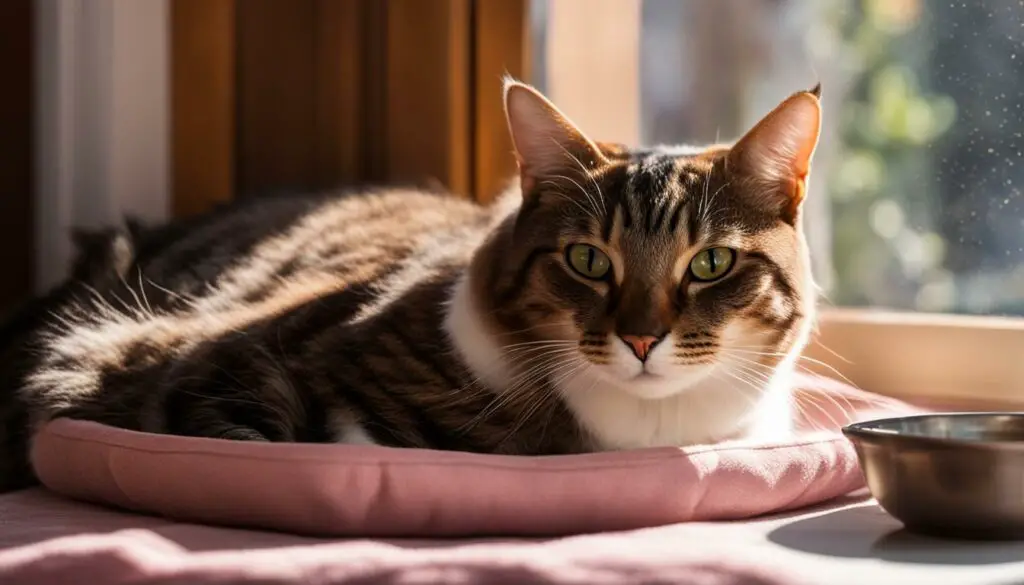
How Much Activity Does Your Pregnant Cat Need?
Physical activity and exercise are important for the overall health and well-being of pregnant cats. While they may naturally become calmer during the later stages of pregnancy, they generally do not require confinement and can engage in regular physical activity. If your cat is accustomed to going outdoors, it is beneficial to allow her access to the outdoors, as it provides mental stimulation and opportunities for exercise.
However, it is essential to prioritize the safety of your pregnant cat. Monitor her behavior and comfort levels closely, and ensure that she is not exposed to any potential dangers or sources of stress. During the later stages of pregnancy, your cat may seek a quiet and comfortable space to prepare for giving birth. Providing suitable areas for nesting and resting will help create a favorable environment for your cat.
Remember that every cat is unique, and their activity levels can vary. It is essential to pay attention to your cat’s individual needs and adjust accordingly. If you notice any signs of discomfort or fatigue, consult your veterinarian for guidance on appropriate physical activity and exercise for your pregnant cat.
| Physical Activity Guidelines for Pregnant Cats | Safety Tips |
|---|---|
|
|
By allowing your pregnant cat to engage in appropriate physical activity and exercise, you can help promote her overall well-being and support a healthy pregnancy.
Recognizing Issues with Your Cat’s Pregnancy
Pregnancy in cats is a delicate period that requires careful monitoring and attention. As a pet parent, it is essential to be aware of potential issues that may arise during your cat’s pregnancy. Recognizing these issues early on can help ensure the well-being of both the mother and her kittens. Here are some signs to watch out for:
Loss of Appetite
A sudden loss of appetite in a pregnant cat can be a cause for concern. If your cat shows a significant decrease in food intake or refuses to eat altogether, it is essential to seek veterinary attention. Loss of appetite can indicate various problems, such as complications with the pregnancy or underlying health issues.
Distress
Distress in a pregnant cat can manifest in different ways, including restlessness, pacing, excessive vocalization, or aggression. If your cat seems unusually agitated or displays abnormal behavior, it is crucial to consult with your veterinarian. They can assess the situation and provide appropriate guidance and treatment if necessary.
Abnormal Vaginal Discharge
Abnormal vaginal discharge during pregnancy can be a sign of infection or complications. If you notice any unusual discharge, such as a foul odor, excessive discharge, or blood, it is essential to seek immediate veterinary attention. Timely diagnosis and treatment can help prevent further complications and ensure the safety of the mother and her kittens.
During your cat’s pregnancy, it is vital to maintain open communication with your veterinarian. They can provide guidance, perform necessary examinations, and address any concerns you may have. By being vigilant and proactive, you can ensure the best care and support for your pregnant cat throughout her journey to motherhood.
Knowing When Your Cat Is Ready to Give Birth
As your pregnant cat reaches the end of her gestation period, it’s vital to recognize the signs that she is ready to give birth. These cues will help you provide the necessary support and create a safe environment for the delivery.
One of the most noticeable signs is when your cat starts looking for a nesting spot. She may seek out secluded areas in your home, such as closets or under furniture, where she feels comfortable and protected. Providing suitable nesting options, like cardboard boxes lined with towels or blankets, can ensure she has a cozy space for delivery.
Monitoring your cat’s body temperature is another important indicator of labor. Just before she goes into labor, her body temperature may drop below 102.02°F. Keep an eye on her temperature using a rectal thermometer to get an accurate reading.
Panting and excessive grooming of the belly and genital area are other signs that your cat is close to giving birth. Panting helps regulate her body temperature during contractions, while grooming prepares the area for the arrival of the kittens. Scratching behaviors may also be observed as your cat prepares the birthing site. These actions are all natural instincts that indicate your cat’s readiness to deliver.
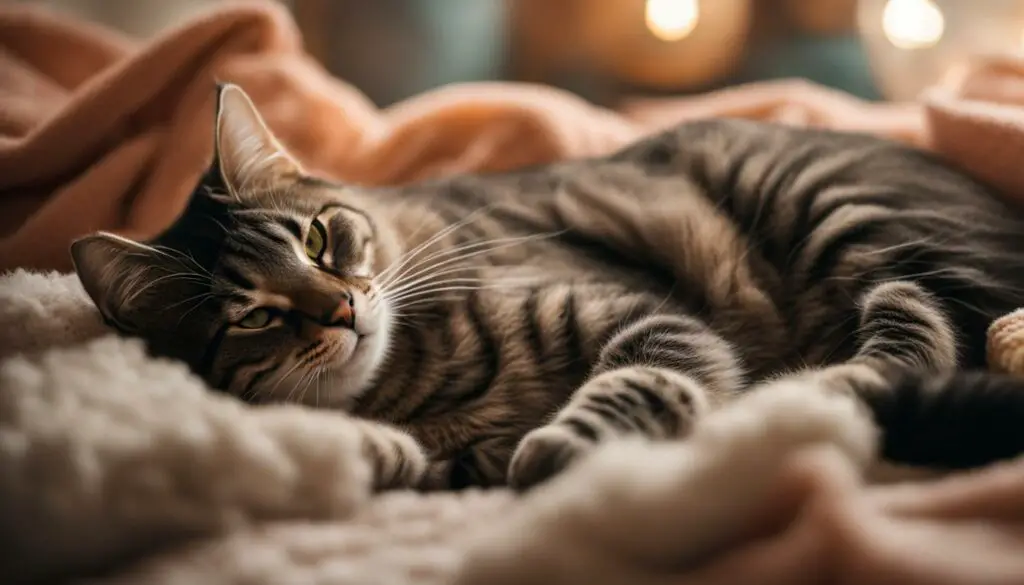
| Signs of Impending Labor in Cats: |
|---|
| Looking for a nesting spot |
| Body temperature drop below 102.02°F |
| Panting |
| Excessive grooming of the belly and genitals |
| Scratching behaviors |
By being aware of these signs, you can be prepared for the upcoming birth of the kittens and provide the necessary support and care for your pregnant cat.
Section 12: Preparing Your Home for Your Cat to Give Birth
Preparing your home for your cat to give birth is an important step in ensuring a safe and comfortable environment for both the mother cat and her kittens. Prior to the expected due date, it is advisable to notify your veterinarian a few days in advance for any necessary preparations or guidance. Here are some key steps to consider when preparing your home:
- Providing nesting spots: Set up suitable nesting spots in secluded areas of your home to offer the mother cat a comfortable place to give birth. Cardboard boxes lined with towels or blankets can serve as cozy and secure nests. While not all cats may use the nests you set up, it is important to provide multiple options to cater to their preferences.
- Confinement: Confining the mother cat indoors closer to the due date can prevent her from giving birth outside and ensure the safety of the kittens. Choose a quiet and warm room where she can feel secure and undisturbed during labor.
- Veterinarian advice: Consult with your veterinarian for specific recommendations based on your cat’s individual circumstances. They may suggest additional measures, such as an ultrasound or x-ray, to estimate the number of kittens and offer further guidance on the birthing process.
By taking these steps to prepare your home, you can create a supportive environment that promotes a smooth and safe birthing experience for your cat. Remember to follow the advice of your veterinarian and monitor the mother cat closely during labor to ensure the well-being of both the mother and her kittens.

The Stages of Labor for Cats
During the process of giving birth, cats go through three distinct stages of labor. Understanding these stages can help pet parents better support their pregnant cats and ensure a safe and successful delivery of the kittens.
Stage 1: Nesting Behaviors and Contractions
The first stage of labor can last up to 36 hours and is marked by nesting behaviors and mild contractions. The pregnant cat may start seeking a secluded and comfortable spot to create a nest for giving birth. She may exhibit restlessness, frequent grooming of the belly and genitals, and may even scratch at surfaces as she prepares for the arrival of her kittens. These nesting behaviors are signs that labor is imminent.
During this stage, the cat’s contractions may appear relatively mild and may not be easily noticeable. However, they are working to prepare the body for the delivery of the kittens. Pet parents should observe their cat closely during this stage to ensure she is comfortable and has access to a suitable nesting area.
Stage 2: Delivery of Kittens
The second stage of labor is when the actual delivery of the kittens occurs. This stage typically lasts a few minutes to half an hour, although it may take longer, especially for larger litters. During this stage, the cat will have stronger and more noticeable contractions as each kitten is pushed out of the birth canal. The mother cat will instinctively break the membrane sac, cut the umbilical cord, and clean the kittens by licking them to stimulate breathing and remove any fluids.
As a pet parent, it is important to provide a calm and quiet environment for the mother cat to give birth and to allow her to take the lead in caring for the newborn kittens. It is advisable to keep a watchful eye during this stage to ensure that each kitten is delivered safely and that the mother cat is providing appropriate care.
Stage 3: Delivery of Fetal Membranes and Placenta
The third and final stage of labor involves the delivery of the fetal membranes and placenta. After each kitten is born, the mother cat will typically consume the fetal membranes and placenta, which is a natural behavior that helps with the removal of these materials and provides important nutrients. Pet parents should not be alarmed by this behavior, as it is part of the normal birthing process for cats.
During this stage, the mother cat may take short breaks between delivering each kitten to rest and care for the newborns. It is crucial to allow her these breaks and to avoid intervening unless there are signs of distress or complications. However, if a membrane or placenta remains partially expelled without being consumed by the mother cat, it is advisable to seek veterinary assistance to ensure there are no retained materials that could cause infection.
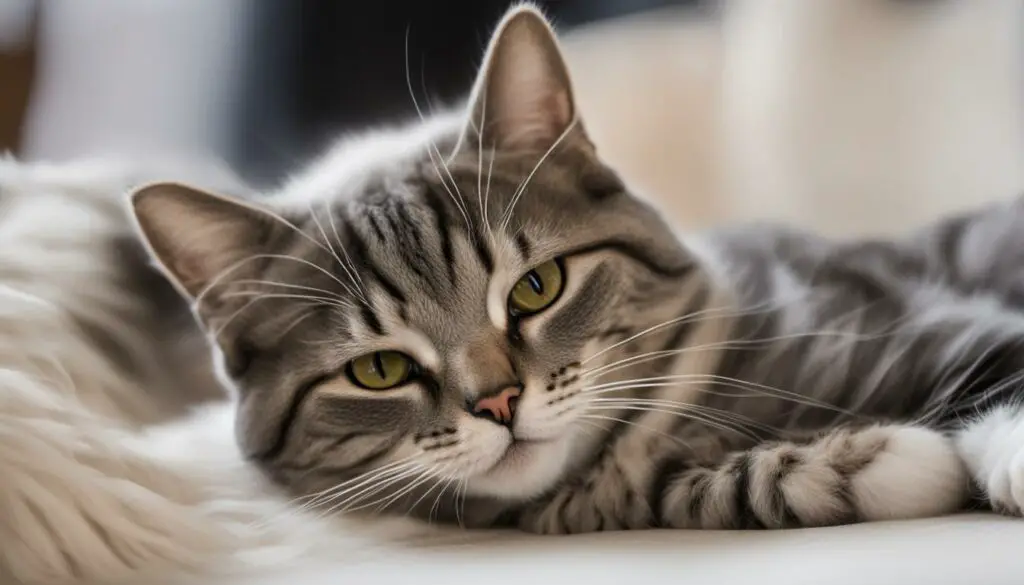
| Stage of Labor | Description |
|---|---|
| Stage 1: Nesting Behaviors and Contractions | The cat exhibits nesting behaviors, such as seeking a secluded spot, and experiences mild contractions as the body prepares for birth. |
| Stage 2: Delivery of Kittens | Stronger contractions occur as each kitten is delivered. The mother cat breaks the membrane sac, cuts the umbilical cord, and cleans the kittens. |
| Stage 3: Delivery of Fetal Membranes and Placenta | The mother cat delivers the fetal membranes and placenta and typically consumes them. Short breaks may be taken between delivering each kitten. |
Caring for Newborn Kittens
Welcoming a litter of newborn kittens is an exciting and rewarding experience. While mother cats usually take care of their kittens without much assistance, there are instances when intervention is necessary, especially if a kitten is rejected. Here are some important aspects of caring for newborn kittens:
- Warming and Feeding: Newborn kittens are unable to regulate their body temperature, so it’s essential to keep them warm. You can provide a heating pad set on low or wrap a hot water bottle in a towel for them to snuggle against. Feeding is a critical aspect of their care, as they rely on their mother’s milk for essential nutrients. However, if a kitten is rejected or the mother is unable to nurse, consult a vet for guidance on feeding with a powdered kitten formula and a suitable feeding method.
- Frequency of Feedings: Newborn kittens need to be fed every two to three hours, including during the night. Their tiny stomachs can only hold a small amount of milk, so frequent feedings are necessary to ensure they receive adequate nutrition. As they grow, the intervals between feedings can gradually be extended.
- Consulting a Vet: It is crucial to consult a veterinarian when caring for newborn kittens, especially if they have been rejected or if there are any concerns about their health. A vet can provide guidance on proper feeding techniques, monitor their growth, and address any health issues that may arise during this critical stage of their development.
Remember, caring for newborn kittens requires patience, dedication, and vigilance. By providing them with warmth, proper nutrition, and veterinary support, you can help give them the best start in life.
| Kitten Care Checklist |
|---|
| Keep newborn kittens warm with a heating pad or hot water bottle wrapped in a towel. |
| Consult a vet if a kitten is rejected or the mother is unable to nurse. |
| Feed newborn kittens every two to three hours, gradually increasing intervals as they grow. |
| Monitor their weight and overall health closely. |
| Ensure a clean and comfortable nesting area. |
| Seek veterinary advice for any concerns or complications. |
Remember, caring for newborn kittens requires patience, dedication, and vigilance. By providing them with warmth, proper nutrition, and veterinary support, you can help give them the best start in life.
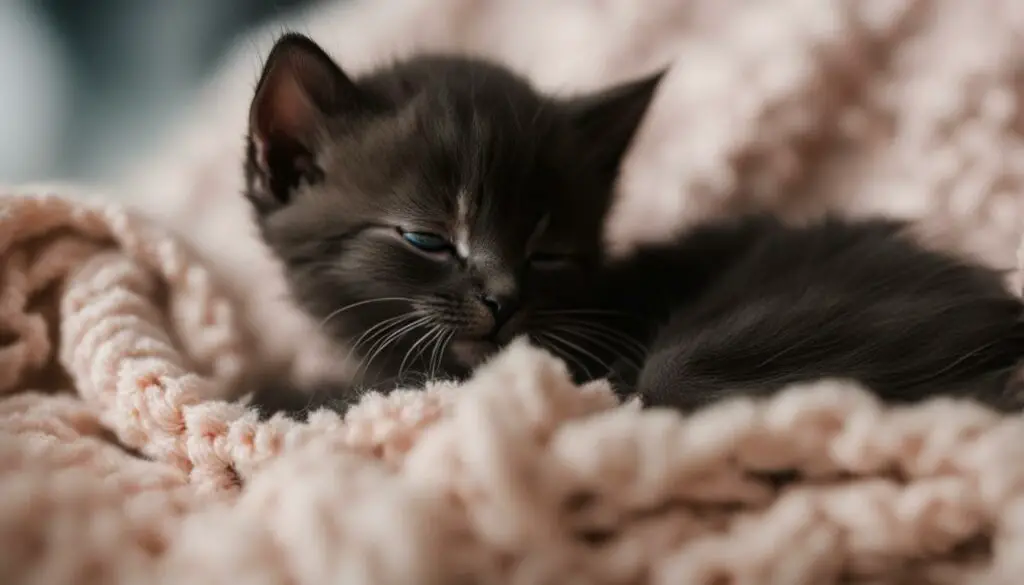
Conclusion
Battling worms is an essential part of maintaining the health of your pregnant cat and ensuring the well-being of her kittens. Roundworms are the most common intestinal parasites in cats and can have severe consequences if left untreated. It is crucial to be aware of the signs and symptoms of roundworm infestation and to take proactive measures to prevent and treat worm infections.
Regular deworming of your pregnant cat is vital to protect her and her kittens from the harmful effects of roundworms. Working closely with your veterinarian, you can develop a deworming schedule that is safe and effective for the expecting mother. Additionally, following a routine parasite prevention program for other common parasites and providing a balanced and nutritious diet will contribute to the overall health of your pregnant cat.
Proper veterinary care, including vaccinations and regular check-ups, is essential to monitor your cat’s health throughout her pregnancy and address any concerns or complications. Being attentive to your cat’s behavior, feeding her according to the veterinarian’s guidelines, and creating a safe and comfortable environment will help ensure a healthy pregnancy and minimize the risk of worm infections.
By taking these steps and working in partnership with your veterinarian, you can provide the best possible care for your pregnant cat and protect her and her kittens from the challenges of worm infections. Remember, a healthy and happy mother cat will contribute to the well-being of her offspring, setting them up for a healthy start in life.
FAQ
What are roundworms?
Roundworms, also known as ascarids, are common parasites that can infect cats. They primarily affect young kittens, older seniors, or cats with weakened immune systems.
How do cats get roundworms?
Cats can become infected with roundworms by ingesting worm eggs or young worms, through nursing from an infected mother, or by eating prey animals that are infected with roundworm eggs.
What are the symptoms of roundworm infection in cats?
Symptoms of roundworm infection in cats may include vomiting, diarrhea, worms in the stool or vomit, decreased appetite, a pot-bellied appearance, abdominal pain, poor growth, weight loss, a dull hair coat, and coughing.
How are roundworm infections diagnosed in cats?
Roundworm infections in cats are commonly diagnosed through a fecal flotation test performed by a veterinarian. However, false negatives are possible, so treatment may still be recommended based on clinical signs.
How are roundworm infections treated and prevented in pregnant cats?
Roundworm infections in pregnant cats should be treated with safe and effective deworming medication recommended by a veterinarian. Pregnant cats should also be on a routine parasite prevention program and kept indoors to minimize exposure to potential sources of infection.
What veterinary care does a pregnant cat need?
Pregnant cats require regular vet check-ups, vaccinations to protect against infectious diseases, and deworming to prevent worm infestations. Postnatal care, including evaluation and potential spaying, is also important.
What should I feed my pregnant cat?
Pregnant cats should be fed a high-quality diet that is rich in calcium and protein. Many veterinarians recommend feeding pregnant cats kitten food, which contains additional nutrients and calories.
How much activity does my pregnant cat need?
Pregnant cats can engage in regular physical activity and exercise. However, during the later stages of pregnancy, they may become calmer and seek a quiet and comfortable space for nesting and resting.
What are the signs of complications during a cat’s pregnancy?
Signs of complications during a cat’s pregnancy may include a sudden loss of appetite, distress, excessive licking of the vulva, abnormal vaginal discharge, blood in the urine, or difficulty urinating. Veterinary attention should be sought if any of these symptoms occur.
How do I know when my cat is ready to give birth?
Typical signs that a cat is ready to give birth include actively seeking a secluded nest, a change in body temperature, panting, and excessive grooming of the belly and genitals.
How should I prepare my home for my cat to give birth?
It is advisable to notify your veterinarian in advance and provide nesting spots, such as cardboard boxes lined with towels or blankets, in secluded areas of the home. Confining the cat indoors closer to the due date can also prevent them from giving birth outside.
What are the stages of labor for cats?
Cats go through three stages of labor when giving birth to kittens. The first stage involves nesting behaviors and mild contractions, the second stage is when stronger contractions occur and the kittens are actively delivered, and the third stage involves the delivery of the fetal membranes and placenta.
How do I care for newborn kittens?
If a mother cat rejects any of the kittens, they should be kept warm and provided with milk using a powdered kitten formula and a suitable feeding method. Consulting a veterinarian for proper care, feeding frequency, and monitoring is essential.








